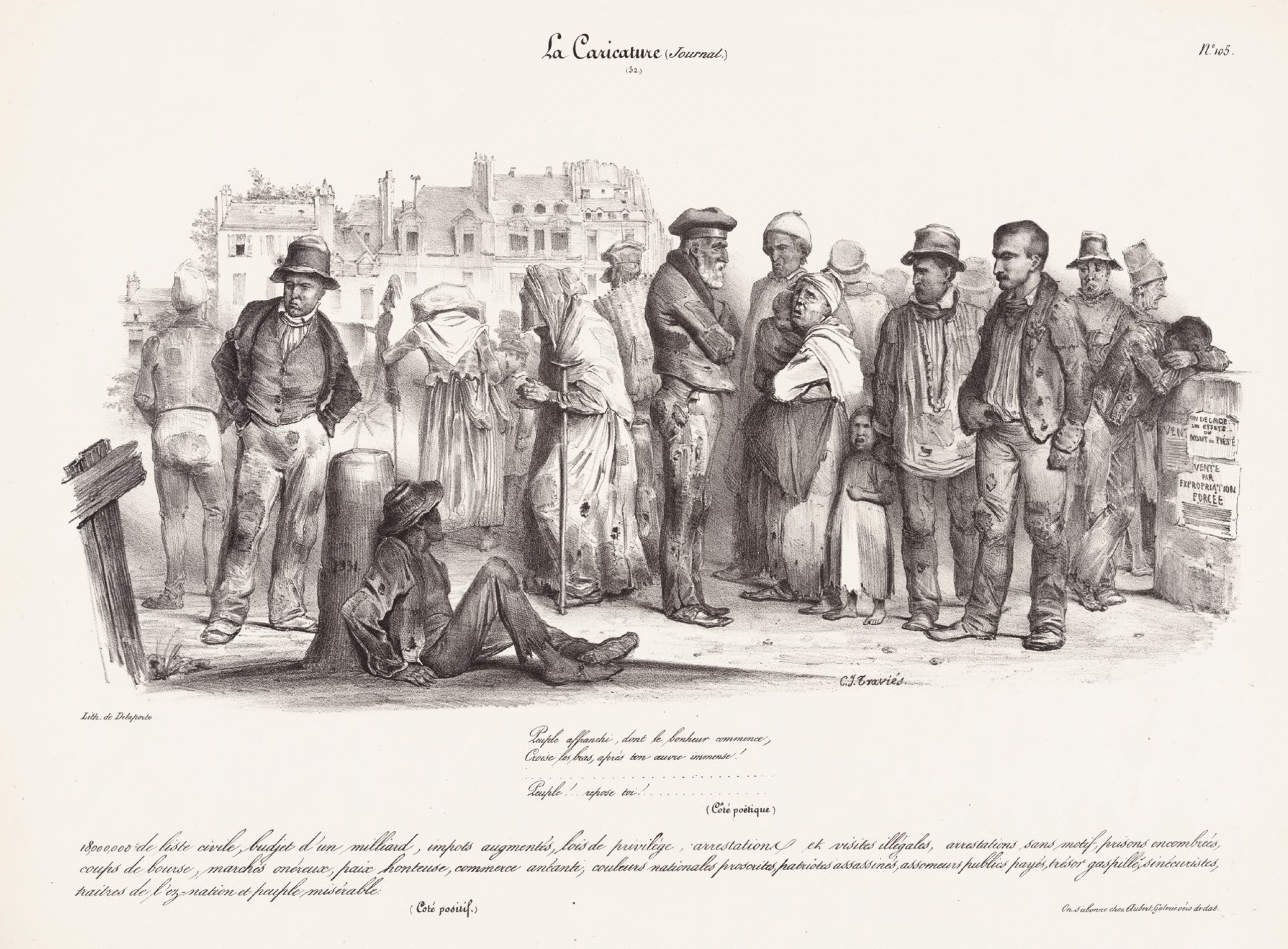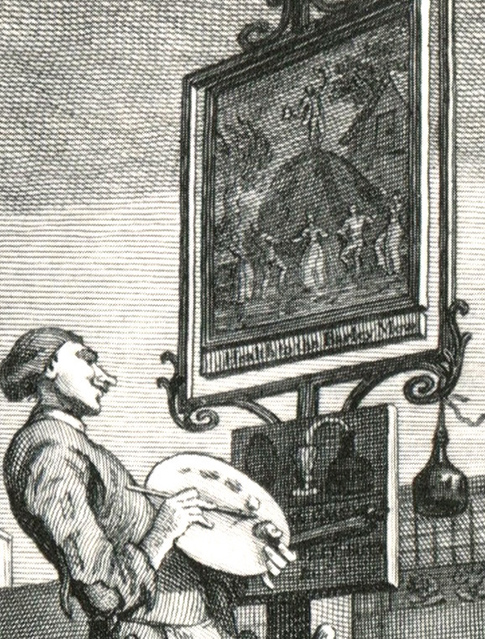Alexander Roob]
[August 1, 2012
From Marx to Ensor: The Revolution Artist Wilhelm Kleinenbroich (1812 – 95)
It really cannot be said that the Kölnische Stadtmuseum is concerned too little with one of its most significant artistic treasures, the oeuvre of the Rhenish historical painter and graphic artist Wilhelm Kleinebroich, quite to the contrary. In 1999 the brilliant monograph “Die Revolution des Malers Kleinenbroich” by Bonn-based historian Horst Heidermann was published there. With it, he achieved one of the rare feats of having elucidated the surprising, expressive diversity of an ignored artist through meticulous research and puzzle work, although the sources are precarious and only a relatively small part of his oeuvre has survived. Future research work will hardly be able to surpass Heidermann’s monograph, now that relevant material of the Kölner Stadtarchiv has been lost.
Wilhelm Kleinenbroich: Die Erhebung der Schlacht – und Mahlsteuer an einem Kölner Stadttor, 1847 (Kölnisches Stadtmuseum, Loan of the Wallraf- Richartz- Museum)
Until then, only very few paintings were known by the artist from a poor background, who first worked as a decoration painter and was then trained for a short period at the Düsseldorfer Kunstakademie, probably as a private student in an independent studio of Carl Friedrich Lessing. His painting Recruten vor der Schenke (1843), in which he attacked Prussian censorship, as well as the socio-critical depiction Die Erhebung der Schlacht – und Mahlsteuer (1847) and the genre painting Der Proletarier (1845) long counted, alongside pictures by Johann Peter Hasenclever, Peter Schwingen and Carl Wilhelm Hübner, as the main works of early-socialist art of the Vormärz. Yet only through Heidermann’s publication did it become clear that Kleinenbroich was one of the most idiosyncratic graphic artists of his time, as well as a portrait and panorama painter who was high in demand, the designer of the political carnival initiated by Franz Raveaux, and a specialist in tableaux vivant critical of contemporary issues, which he created preferably based on press graphics of the Leipziger Illustrirte.
Wilhelm Kleinenbroich: Der Proletarier, 1845 (Stiftung Volmer, Wuppertal)
Now, twelve years after the publication of this monograph and on the occasion of the artist’s 200th birthday, the Stadtmuseum presents a survey exhibition that cannot be called comprehensive, but that documents the work of the artist from all known phases of his artistic career. The fact that a museum dedicated to the city’s history is not necessarily the most adequate venue for presenting such an artistically extraordinary work, is reflected in the curators’ efforts to cultural-historically jazz up the show by applying materials from the time. The confrontation of Kleinenbroich’s watercolours with an exhibition on the history of the German national flag elucidates very little, while greatly disturbing one’s concentration on the works.
Wilhelm Kleinenbroich: Die Barrikade am Altermarkt, undated (Kölnisches Stadtmuseum)
Wilhelm Kleinenbroich: watercolour and ink drawing, undated (Kölnisches Stadtmuseum)
Wilhelm Kleinenbroich: watercolour and ink drawing, undated (Kölnisches Stadtmuseum)
German art of the 19th century is really not that rich in such idiosyncratic positions. Particularly in the German generation of ’48, interrupted and artistically half-baked work sequences are the rule. One often forgets that, at the time, Prussian reaction not only led to a devastating decline of progressive forces in the political arena, but also in the field of culture. Against this background, the cycle of 55 watercolours (some only passed down in the form of photographs), in which the artist, most likely well advanced in years, passed the revolutionary events in Cologne in review, gain all the more weight. In their exuberant fantasy and painterly intensity, the sheets already anticipate a James Ensor. The early paintings of Kleinenbroich, who in the circle of his colleagues had the nickname “Tizian”, had attracted attention due to their challenging colouring. In his late watercolours, he then in an unprecedented manner unleashed his urge to employ a more flowing painterly style with garish colours.
Wilhelm Kleinenbroich: Durcheinander # 5, 28.1.1849 (Kölnisches Stadtmuseum)
His extraordinary inventiveness is also expressed in the cycle of caricatural lithographs entitled “Durcheinander”, which he published in thirteen issues in 1848 and 1849. None of his colleagues from the context of the Düsseldorfer school of painters, who concurrently did exercises in political caricature in the esteemed Düsseldorfer Monatsheften, came to comparably brilliant results. A style-critical comparison of these emblematic works with the probably best-known early-communist icon, the new Prometheus, an 1842 allegory of the censorship measures against the Rheinische Zeitung edited by Karl Marx, can only reinforce Horst Heidermann’s presumption that the anonymous author was with great probability young Wilhelm Kleinenbroich. (Heidermann convincingly supports this speculation in his book with a chain of arguments spanning more than five pages.)
Wilhelm Kleinenbroich: Der neue Prometheus, Düsseldorf, 1842 (Museum Karl-Marx-Haus, Trier) (Möglicherweise handelt es sich bei dem bärtigen Titanen um eine idealisierte Darstellung des verantwortlichen Chefredakteurs der Rheinischen Zeitung, Karl Marx)
Later on, though, the artist was by no means a follower of Marx. When in September 1848 Marx seized the helm of the Kölner Arbeiter-Verein, which Kleinenbroich had co-founded, the painter promptly turned his back on the social-reformist education society. After the victory of the Prussian counterrevolution, the gates of art institutions remained closed to the popular artist, even those of the Kölnische Kunstverein, which he had co-founded. Even plans for a posthumous remembrance show could not be realised in the reactionary empire. Today one would wish for an exhibition that adequately honours the excellence of Kleinenbroich’s oeuvre, thus lifting the not only in political terms revolutionary artist above the society of a Rhenish regional league.
The exhibition is on view until 09/14/2012 at the Kölnische Stadtmuseum









